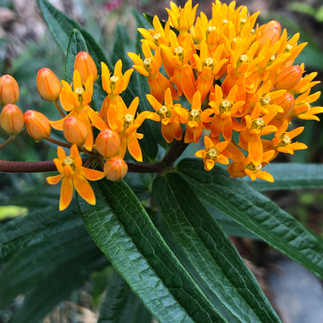Townhome spaces: a native here, a native there.

The front entrance to Sarah's townhome says welcome and more. It's clear someone with an eye for color and design lives in this home. This townhome is like many -- a narrow garden alongside a front loading garage and driveway. Sarah has made the utmost of this 8' by 20' full sun space making it inviting year round.

At the sidewalk, a large guara (Guara lindheimeri) greets visitors with tiny pink and white blooms that sway at the slightest hint of a breeze. Guara, a long blooming perennial native to Texas, is often called "whirling butterflies." From there, your eye is drawn up the path of pavers edged with a carpet of mint colored, fuzzy thyme (Thymus coccineus group), an ornamental ground cover that softens the stepping stones and helps prevent weeds. Each step brings a new perennial to either side.
Natives intermingle with some of Sarah's favorite ornamentals: peonies, hostas, and lenten rose and two ornamental evergreens. She has been bitten by the native bug, so to speak, and has added native summer blooming perennials one by one.
The two tickseeds are the first of these to bloom. The feathery foliage of the whorled tickseed (Coreopsis verticillata) contrasts in texture with the other plants even after it has finished blooming. Lobed tickseed (Coreopsis auriculata) has wider leaves and a more compact rosette type base, also providing texture.
Monarch's Delight (Asclepias tuberosa), coneflower (Echinacea purpurea) and black-eyed susans (Rudbeckia fulgida) come into bloom next. The punches of orange, pink and yellow brighten the home's entrance and give the small garden a big profile.
Toward mid-summer, white liatris (Liatris spicata 'alba'), little lemon goldenrod (Solidago 'Dansolitlem' Little Lemon) and bright blue lobelia (Lobelia siphilitica) add even more color.
The foliage of the ornamentals, several hostas (Hosta), peonies (Paeonia), and the lenten rose (Helleborus orientalis) anchor the flowering perennials with their foliage which stays upright and green through the growing season. The space is grounded in winter, by two ornamental evergreens and the lenten rose which begins blooming in March.
Looking at how this space has been maximized for impact, it will not surprise you that Sarah, world traveler, Mom of two, founder of her consulting business, thinks nothing of creating a full sized boat dock out of cardboard for the local elementary school fundraiser. She also loves to create baked confections. This is one busy gardener who doesn't have loads of time to devote to a garden.
Sarah says when the front bed was first planted to replace raggedy grass and dirt out front, she went with whatever the landscaping crew recommended. "As plants die because they are the wrong plant for our soil and sun conditions, I replace with natives." She characterizes her approach as a 'renegade gardener.' Sarah says she has no gardening principles; she just learns as she goes. Don't we all!

Her plant selections are great examples of plants that make it on their own while still looking good. These don't really require deadheading and with a series of perennials that shine at different times of the growing season, there is always at least one plant doing its thing, making the entire garden look purposeful and beautiful at the same time. The array of seed heads feeds birds through summer, fall and into winter. The evergreen anchors, long lasting foliage of lenten roses and liatris create the structure for the small garden.
Native Alternatives
Should you want to create such a path of your own using only natives, here are some possible alternatives for some of these ornamentals.
Creeping thyme: substitute pussytoes (Antennaria plantaginifolia) to provide a minty green tough as nails ground cover.
Hosta: substitute American alumroot (Heuchera americana) or the larger heuchera 'Autumn Bride' (Heuchera "Autumn Bride") to provide long lived strong green foliage color.
Peonies: substitute blue false indigo (Baptisia australis) for stunning early summer flowers and long lasting foliage.
Hinoki cypress: substitute eastern red cedar "burkii" (Juniperis virginiana "Burkii") a smaller cultivar that grows to 10 to 15' tall or eastern red cedar "grey owl' (Juniperis virginiana "Grey Owl') which grows to 3' tall and 6' wide.
It amazes me what one can do in a small space. Well, what someone like Sarah can do in a small space!

























Comentários